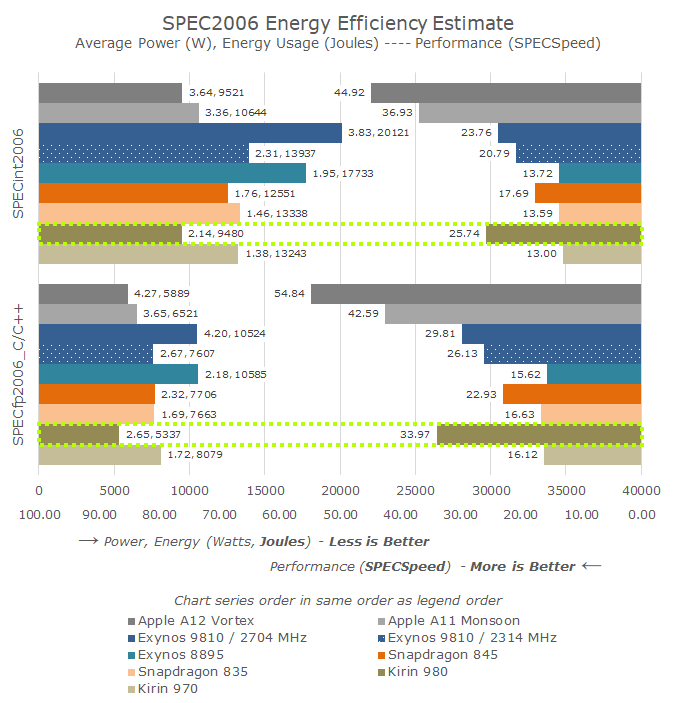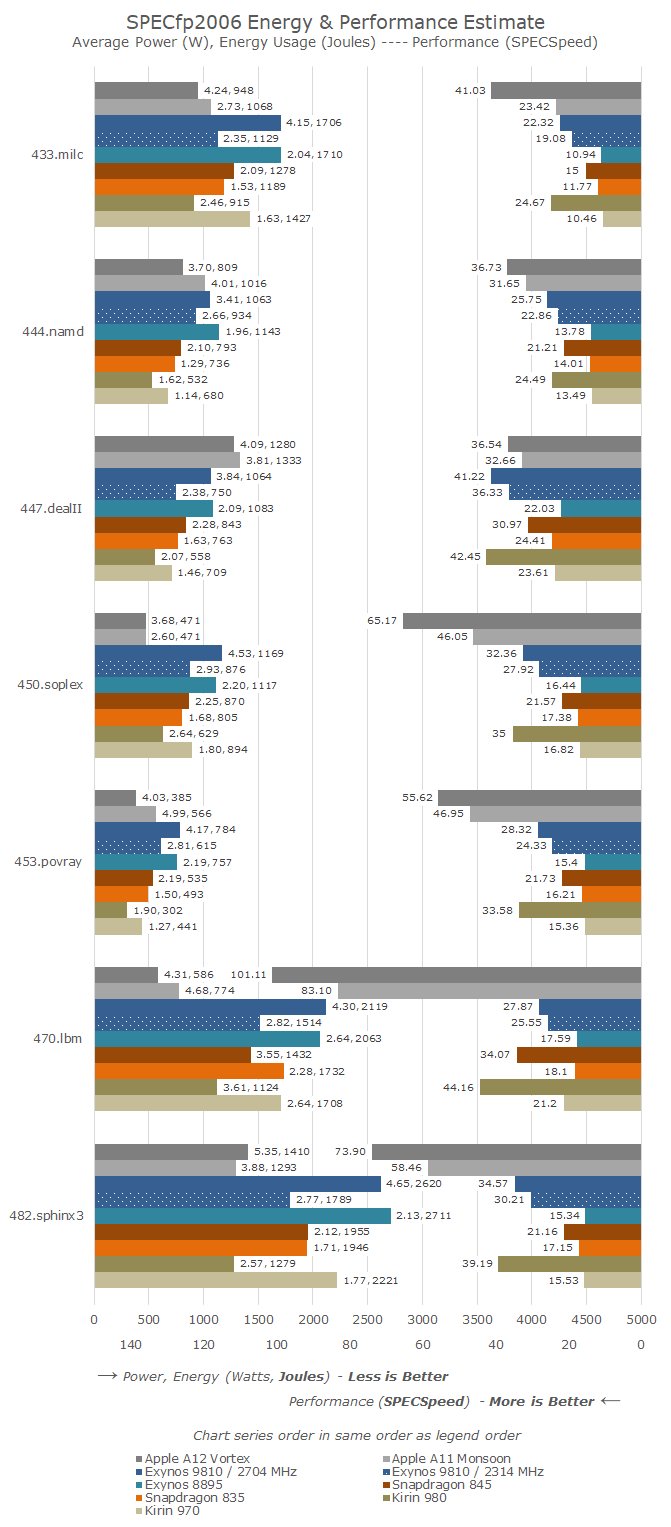The Mate 20 & Mate 20 Pro Review: Kirin 980 Powering Two Contrasting Devices
by Andrei Frumusanu on November 16, 2018 8:10 AM EST- Posted in
- Smartphones
- Huawei
- Mobile
- Kirin 980
- Mate 20
- Mate 20 Pro
SPEC2006 Performance & Efficiency
HiSilicon made some big promises for the Kirin 980, claiming up to 75% higher performance while improving efficiency by 58%. This time around for our analysis, I’m starting with the results off the bat and going into the more detailed analysis later.
We’re picking off with our mobile SoC SPEC2006 results where we left off in our Apple A12 analysis, and add the scores of the new Kirin 980 to the new set.
As a reminder, as the scores aren’t submitted to SPEC, we have to put a disclaimer that these are just estimates as they aren’t officially validated. Naturally, we verify that the tests are run correctly in-house.
When measuring performance and efficiency, it’s important to take three metrics into account: Evidently, the performance and runtime of a benchmark, which in the graphs below is represented on the right axis, growing from the right. Here the bigger the figures, the more performant a SoC/CPU has benchmarked. The labels represent the SPECspeed scores.
On the left axis, the bars are representing the energy usage for the given workload. The bars grow from the left, and a longer bar means more energy used by the platform. A platform is more energy efficient when the bars are shorter, meaning less energy used. The labels showcase the average power used in Watts, which is still an important secondary metric to take into account in thermally constrained devices, as well as the total energy used in Joules, which is the primary efficiency metric.
Both the SPECint2006 and SPECfp2006 overall scores paint a much better picture than HiSilicon lead us to believe in their estimates, and the figures are also ahead of what I had personally estimated using Arm’s marketing materials during the Cortex-A76 launch.
Against the Kirin 970, the Kirin 980 is sporting about flat out double the SPEC2006 performance. Naturally this is a comparison between SoCs two CPU generations apart, but it’s still an outstanding showing because the improvements were not only in the benefit of performance, but also energy efficiency.
The Kirin 980’s energy usage while completing the workloads is among the best in the space, ending about in the same range as Apple’s A12 SoC, slightly eding it out in SPECint2006 as well as SPECfp2006.
We have to remember that the energy usage isn’t the same as power efficiency: While energy usage of a workload is an immensely important metric that will very much correlate to the battery life of a device, the power efficiency of a CPU and SoC is something needs to take into consideration the actual performance as well. In this case, the actual perf/W of the Kirin 980 is only about 28% better than the Kirin 970. So if performance has doubled, and energy usage has also gone down, then it means that something had to give, and that is the power usage.
The new Cortex-A76 cores and the memory subsystem of the Kirin 980 are a lot more power hungry, reaching 2.14W average in SPECint and 2.65W in SPECfp, a notable increase over the 1.38W and 1.72W of the Kirin 970. In a sense, Arm’s new microarchitectures, including the Cortex-A75 of the Snapdragon 845, have been able to increase their performance in a more linear fashion alongside power.
Now this is not really a negative as long as the relationship between gained performance and raised power usage is kept in check. The best example is obviously Apple’s SoCs, which do sport very high power figures, but also come with very high performance. The best counter-example is the Exynos 9810’s higher frequency states, which come with similarly high power requirements, however don’t showcase an equal increase in performance, thus resulting in a big efficiency disadvantage.
Looking at the wider range of historical SPEC2006 scores, we see the Kirin 980 just losing out to Apple’s A10 in terms of performance. As I had expected some months ago, the A76 largely puts the vastly bigger and more complex Exynos M3 to shame as it manages to post better performance while at the same time using much less power as well as using about half the energy to complete the benchmark.
While Arm has already disclosed the key aspects and improvements of the Cortex-A76 microarchitecture, we can still go over the more detailed SPEC2006 subtests to see if we can extract any further meaningful information:
In SPECint2006, the Kirin 980’s gains are quite relatively even across the board, possibly showcasing a more balanced approach towards the different aspects of the microarchitecture. The biggest generational gains were found in 403.gcc where we see a 2.67x improvement over the Kirin 970. It’s a bit unfortunate that we don’t have a better “apples-to-apples” comparison to the Cortex-A75; the Snapdragon 845’s DRAM memory latency isn’t very good due to its “L4” system cache block, which does handicap it a tad in SPEC.
456.hmmer and 464.h264ref are the two most execution backend bound tests in the suite, and the Cortex-A76 again performs excellently here, showcasing scores that are about in line what you’d expect from the 4-wide microarchitecture as well as clock frequency. I might sound like broken record by now, but again this comes at a great contrast versus Samsung’s M3 core, which in theory just should perform much better than it does.
Something that’s also obvious here is that even though the Cortex-A76 and Kirin 980 are able to show good improvements, it’s not enough to even remotely close the big performance gap in memory latency and bandwidth sensitive tests – here Apple’s monstrous memory subsystem is just that much further ahead.
In the SPECfp2006 results, we again see some really big improvements of the Kirin 980 versus the 970. Again the generational improvement over the A75 is a bit clouded through the comparison to the Snapdragon 845, which in these memory sensitive tests didn’t manage to separate itself much from the previous Cortex A73 based Snapdragon 835.
Still, all, in all, we see very rounded off improvements across the board in all benchmarks, which fares very well for the Kirin 980 both in terms of performance gains as well as energy usage improvements.
Overall, the Kirin 980 as well as Arm’s Cortex-A76 both delivered on their promises on the CPU side, and even managed to surpass by initial performance projections of the new core. No, the Kirin 980 certainly is not able to match Apple’s A12, or even A11 for that matter, and it’s likely this situation won’t change all that much in the next few generations, at least until the Android SoC vendors invest in significantly better and more robust memory subsystems.
The Kirin 980’s performance here should largely represent what we’ll see in the next generation Snapdragon as well – I expect Qualcomm to be able to push the clocks just slightly more, but the big question here is what they will do on the memory subsystem side and if they’ll be able to get rid of the latency penalty that was introduced with the L4 system cache.
For Samsung, the Cortex-A76 is just scary (Apple aside). If the next generation M4 core is just an iterative microarchitecture, I have a really hard time seeing it compete. Here we’ll need to see major improvements both in performance as well as power efficiency in order to have the next gen Exynos to be able to match the Kirin 980, yet alone beat it.














141 Comments
View All Comments
tuxRoller - Saturday, November 17, 2018 - link
First, these phones are, at best, based on 4.14.Second, 4.20 is at least a month from release.
Third, what's Intel got to do with an article about a Huawei phone?
GreenReaper - Sunday, November 18, 2018 - link
They backported it to stable, too; but I agree, it's a little off-topic.tuxRoller - Monday, November 19, 2018 - link
OK. Not sure what happened to my comment...4.19 will, (very) likely, be the next base for aosp. So yes, currently that's stable. Of greater issue is that I see this patch being reverted (though something is going to get pulled). That was why I mentioned that 4.20 still has a month (or more) until it's released.
Beararam - Saturday, November 17, 2018 - link
https://threader(dot)app/thread/1051204370543648770?
Sanyogita - Saturday, November 17, 2018 - link
I know NOMU has been working on rugged phones for a long time, and this time the new product looks great and has a high level of protection.https://nomu.hk/
stanere - Saturday, November 17, 2018 - link
>also finally Huawei’s first phone to push beyond 1080phonor 8 pro and mate 9 pro had 2560x1440 screen
asfletch - Sunday, November 18, 2018 - link
Yep - and the Mate 10, which Andrei clearly has access to (official specs: https://consumer.huawei.com/au/phones/mate10/specs... Rest of the review was great, but odd oversight there.Incidentally, does Mate 20 not have the CABC issue? I remember the Mate 10 (LCD) suffering from it.... It's unfortunate about Huawei's CABC/calibration issues, because when I actually look at the Mate 20 in stores here, the screen is superficially very impressive. I don't know whether it's the lamination process or glass treatment or something, but IMHO icons/text really look 'printed on' in a way which eludes most other phone screens. M20 Pro has similar quality in this regard to my eyes, but I can't deal with curved screen edges.
(As an aside, a flat Galaxy S9 would have been my ideal phone and I was disappointed when the S9 Active was cancelled. These Mates and other top contenders are just huge).
Dan86 - Saturday, November 17, 2018 - link
Looks impressive, but, we shouldn't be buying Chinese crap, made by stealing intelectual property, cloning the note 9, and to make everything worst they will spy on you and store your data in a country were privacy doesnt exist due to the government power over companies, do you really want to buy this phone ???halcyon - Saturday, November 17, 2018 - link
Why shouldn't we? All companies steal IP (read Snowden's revelations, how NSA backdoors are used for industrial espionage). Chinese are not different. And USA/NSA read all your emails, SMS, listen on your phone doors and backdoor your Android phones.Just buy a phone that you are happy with. Leave the nationalistic politics for everybody else to decide (many nationalities, many points-of-view).
I'd buy Huawei Mate 20X, IF they allowed bootloader unlocking AND IF it was availabe in the 8GB/256GB model outside China (it is not).
The nano memory card is a proprietary joke at 128GB (current) max size, imho.
And lack of 3.5mm headphone on the Mate20Pro totally kills it for me.
Spying I couldn't care less about - there's nothing I can do abou it, whether on Samsung, Pixel, LG, Xiaomi or other device. Only if I buy a fully unlocked, rootable phone where I install LineageOS custom ROM (with crap camera drivers) can I *maybe* avoid some snooping. Even then, all the Google apps spy on me.
So, choose your poison, but don't expect that others are not poison too.
shompa - Sunday, November 18, 2018 - link
Dear Dan86. You are what's called a real racist. BTW: you know that every single phone is MADE in China? There are no fabs in US/EU. Intellectual property is a construct. You should ask why all this stuff is not made in your country (and I can give you a hint: it have nothing to do with the workforce like the politicians/companies says)